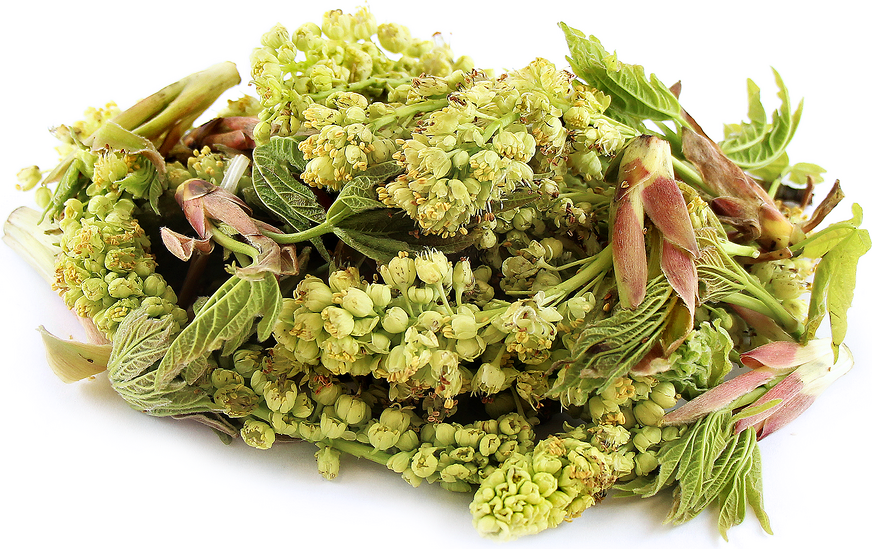


Maple Blossoms
Estimated Inventory, lb : 0
Description/Taste
Maple blossoms emerge from a red-green sheath in the early spring and are comprised of clusters of small round buds averaging less than three millimeters in diameter. The developing cup-shaped flowers are compact, tender, and delicate, and as the flowers mature, they become larger, hanging father from the tree in cascading groupings. Maple blossoms are typically harvested young before the new leaves appear, as older blooms will produce a cotton-like material that is unpleasant to consume. The flowers have yellow pollen and sweet nectar, creating a subtle aroma and typically bear yellow-green hues, but depending on the variety, the blooms can also be orange, red, green, or yellow. When consumed fresh, Maple blossoms are crisp, emitting a delicate floral sweetness, subtle astringency, and green, honeysuckle, and nutty nuances. The entire flower cluster is edible and maintains a neutral flavor profile in both raw and lightly cooked preparations.
Seasons/Availability
Maple blossoms are available in the spring.
Current Facts
Maple blossoms are the young flowers that seasonally appear on maple trees, botanically a part of the Acer genus in the Sapindaceae family. Several varieties of maple trees produce edible flowers, but the most well-known Maple blossoms grow on the bigleaf maple tree, Acer macrophyllum. Maple blossoms are viewed as a specialty foraged ingredient, only appearing for a short time in the spring. Each big leaf maple tree can produce thousands of Maple blossoms in one season, but many of the clusters are out of reach due to the tree's large size. Maple blossoms are foraged just before the developing leaves begin to mature, and the flowers are primarily consumed raw or lightly cooked to retain their delicate, vegetal flavor.
Nutritional Value
Maple blossoms have not been extensively studied for their nutritional value. Like other edible flowers, the blooms may contain some vitamin C to strengthen the immune system, boost collagen production, and reduce inflammation. The blossoms may also provide lower amounts of potassium, vitamin A, calcium, iron, fiber, and phosphorus.
Applications
Maple blossoms have a neutral, sweet, and vegetal flavor well suited for raw and lightly cooked preparations. The blossoms lend themselves to both sweet and savory dishes, and the flower clusters are entirely edible. Maple blossoms can be stripped from the flower stem and tossed into salads and soups, or they can be blended into pesto and other raw herbal sauces. The flowers can also be incorporated into pancake batter, stirred into quiche, used to flavor crème brulee, or cooked into baked goods. In addition to stripping the flowers, Maple blossom clusters can also be left intact to provide crevices for sauces and vinaigrettes to cling to the blossoms properly. Maple blossoms are favored for their tender, crisp texture more than their neutral flavor and can be stir-fried, sauteed, or dipped in batter and fried into fritters, sprinkled with salt or powdered sugar. Chefs also enjoy pickling Maple blossoms to create a tangy taste or infusing the blooms into syrups and cordials. Maple blossoms pair well with herbs such as mint, basil, and parsley, lemon, other spring vegetables, eggs, pumpkin seeds, vanilla, and light vinaigrettes. The blossoms should be used immediately after harvest for the best quality and flavor. They can also be stored for 1 to 2 days when kept whole in a sealed container in the refrigerator.
Ethnic/Cultural Info
In the Pacific Northwest, foragers primarily harvest Maple blossoms from bigleaf maple trees. This very large tree is also known as the broadleaf maple and can reach up to 33 meters in height, considered one of the largest maple trees native to North America. Bigleaf maple trees also have a unique visual appearance as the trunks are often covered in thick layers of moss, and the leaves can grow to extend over 60 centimeters in diameter. For centuries, all parts of bigleaf maple trees have been used by native populations in North America. The flowers are used as a fresh culinary ingredient, the tree sap can be boiled into a type of maple syrup, and the wood is carved for furniture, musical instruments, and façade work.
Geography/History
Maple blossoms from the bigleaf maple tree are native to forests along the North American Pacific coastline, extending from British Columbia to San Diego County. The trees can tolerate a wide range of temperatures and moisture levels but thrive in areas with a freshwater source. Today bigleaf maple trees can still be found in their native range, and when in bloom, Maple blossoms are generally harvested fresh and are a specialty ingredient mainly incorporated into home cooking. Some Maple blossoms may also be occasionally sold through farmer’s markets or boutique retailers.
Recipe Ideas
Recipes that include Maple Blossoms. One
| Fat of the Land |
|
Maple Blossom-Mint Pesto |
| Salt + Fat + Whiskey |
|
Maple Flower Spring Rolls |
| Happy Vegetable Cow |
|
Quick-Pickled Maple Blossoms |
| Tall Clover Farm |
|
Maple Blossom Fritters |




